What is Scaffolding in Construction?
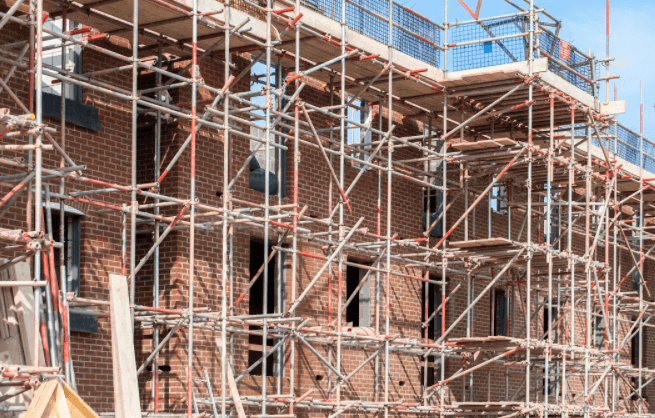
Scaffolding is a construction platform that is temporarily used to supply, support and lift materials during the construction process for cleaning or repairing of the structure. It is installed before the maintenance or construction work begins. Scaffoldings are very important and necessary for a construction work of a building. Here it is discussed about the types of scaffolding and the parts of scaffolding.
These comes under safety regulations on construction sites and standards have been prescribed for its layout and usability. For example; when a person is responsible to fall from a height of more than 2m, a guardrail should be given to a height of 1m and furthermore a toe board something like 200mm over the stage. Scaffoldings are generally placed around the exterior of the building or the construction structure and in the multi-story buildings these scaffoldings are assembled up to extremely huge heights. There are several parts of scaffolding in construction. The parts of scaffolding in construction are described below.
As around 35% – 40% of the relative multitude of accidents that occur in building construction sites is because of faulty or flawed scaffolding and consequent fall of persons from heights, strict supervision should be taken in setting up of scaffolding as indicated by standard practices. To limit accidents on the construction site because of broken scaffolding, you can take a stab at recruiting industry experts like Bristol scaffolding.
Types of Scaffolding
There are several types of scaffolding in construction, such as:
1. Steel Scaffolding or Tubular Scaffolding
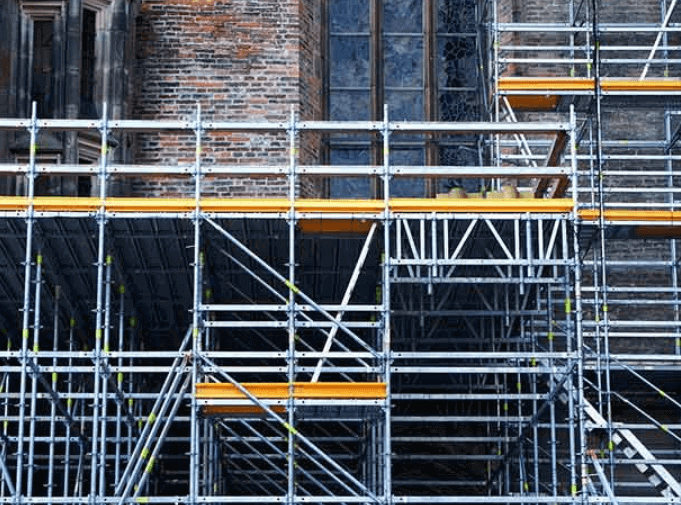
In construction sites the use of the steel scaffolding are similar to the timber scaffolding. In this types of scaffolding the wooden members are replaced by 38mm – 64mm diameter steel tubes and rope lashings, special types of fittings or steel couplets are used for connecting various members. For conventional low rise buildings, it is not unexpected to use casuarinas or bamboo integrated by coir ropes for scaffolding as such works will in general be modest.
In any case, it should be remembered that these poles lose their strength after exposure to sun for around 6 – 9 months and may have be replaced. Additionally, coir rope joints should be analyzed intermittently for their tightness. The steel tubes used for scaffolding for typical building construction work are weighty class and of diameter fluctuating from 40mm – 60mm.
In this types of scaffolding the vertical tubes called standards or uprights are spaced into 2.5m – 3.0m separated. Every standard is welded to a base plate, circular or square in plan. The base plate consisting of holes so as it can be spiked to a concrete base or timber and hence it framed a rigid foundation for scaffolding. Ledgers or the longitudinal tubes connecting the standards or uprights are spaced at 1.80m vertically separated.
Short tubes or putlogs are regularly 1.20m – 1.80m long. The putlogs have special ends to squeeze into the joints in the wall and thus no large holes are needed to be left on the wall for their bearing. Tubular scaffolding has several advantages over timber scaffolding such as quick dismantling and erection, more prominent strength and toughness, salvage esteem and higher fire resisting qualities.
In spite of the fact that it works out to be costlier at first yet considering its several advantages and the increased number, of reuses it proves to be conservative over the long haul and consequently it is as a rule extensively used these days. The tubular scaffolding mounted on the wheels can also be used for doing the works like wall paintings, underside roofs, and so on.
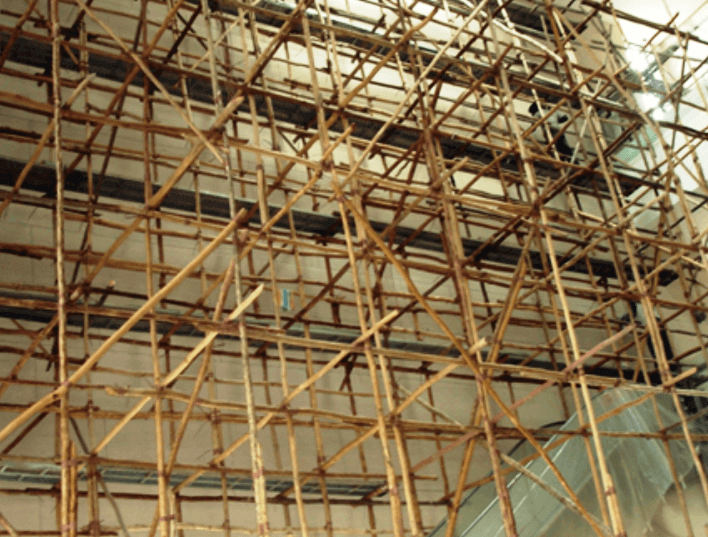
2. Bricklayers Scaffolding or Single Scaffolding
This types of scaffolding is for the most part utilized for the brickworks and comprising of an outer line of verticals which are by and large known as guidelines to which the longitudinal individuals are tied at various degrees of working. The putlogs or the cross members are attached to the uprights or standards at the exterior end and rest on the walls being worked inside. The stage is carried on the putlogs. In the event that the putlogs level coincides with an opening in the wall, it can’t be placed on the wall.
Henceforth, it should rest on a cross piece which is also known as bridle tube tied at the wall end of the adjacent putlogs. Cross bracing in the vertical planes between the verticals are also to be presented for lateral stability. Where the vertical posts can’t be placed in the holes that are made in the ground or on the base plates. It should be suitably placed and prepared for lateral stability.
A well known technique in such cases is to place the vertical post in a steel barrel of 60cm in height and of suitable diameter loaded up with compacted earth.
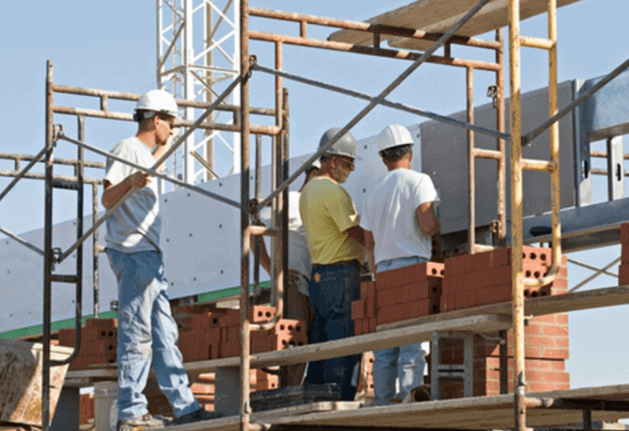
3. Masons Scaffolding or Twofold Scaffolding
This types of scaffolding is used by the masons for supporting system for the purpose of plastering. It has pairs of external and internal verticals. The putlogs, instead of being supported on the wall, are supported on an inward system of verticals and longitudinal. To give extra lateral stability to the narrow and tall framework, it is attached to the building at intervals when used for multi-story building.
4. Cantilever Scaffolding or Needle Scaffolding
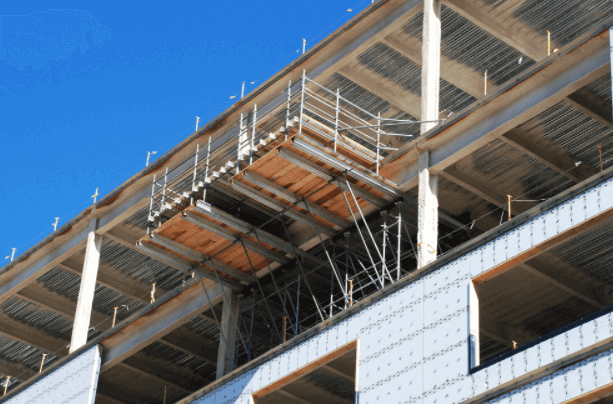
For the construction of the upper piece of a tall residential building, cantilever scaffolding eliminates undesirable scaffolding at lower levels keeping the space free for vehicles, and so on. It is similar to the twofold scaffold, then again, actually it is supported at the base by a cantilever prop.
5. Birdscage Scaffolding

This types of scaffolding is used for the inner works of the construction consisting of a simple cage that are supported on four verticals and workers work easily from this. It is not a fixed support. This types of scaffolding are portable and can be moved easily from one place to another.
6. Ladder Scaffolding or Trestle Scaffolding
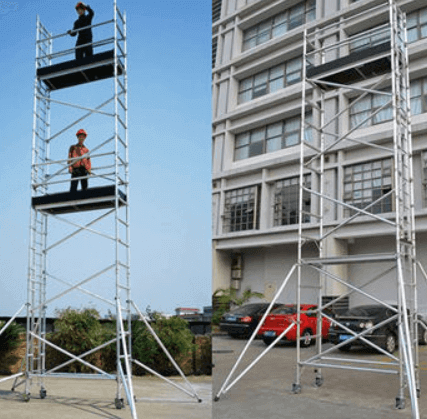
This is used for light work and is usually versatile. This types of scaffolding consists of two ladders where the top ends are combined by planks or platform so that a person can work on this above stage.
7. Suspended Scaffolding
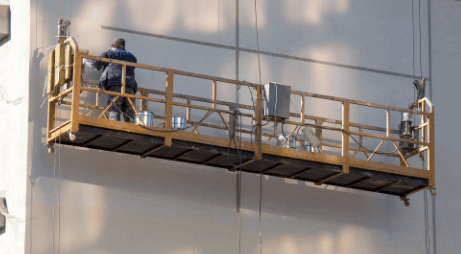
In tall buildings for working at significant levels, such as the painting of tall buildings, it is more helpful and efficient to suspend the working stage from over the ground than to support it from the ground. This is especially so when the height is in excess of 30m.
Suspended scaffolds are divided into three types of scaffolding. The types of suspended scaffolding in construction are, fixed sort suspended scaffolding, suspended scaffolding worked by pulleys and suspended scaffolding worked by winches. Provision for stability should be accommodated in these when using them in places subjected to substantial breeze forces.
- Fixed Sort Suspended Scaffolding: This types of scaffolding are very simple scaffolding which are connected or joined to a roof truss of the site work by using chains, tubes, ropes and so on.
- Suspended Scaffolding Works by Pulleys: These are the types of scaffolding that resembles the platforms of the painters of buildings and cleaners of windows.
- Suspended Scaffolding Works by Winches: These types of scaffolding are arc substantial platforms that are hung by wires from brief outriggers and worked by outside cranes.
Parts of Scaffolding
The are several parts of scaffolding in construction. The parts of scaffolding in construction are as follows:
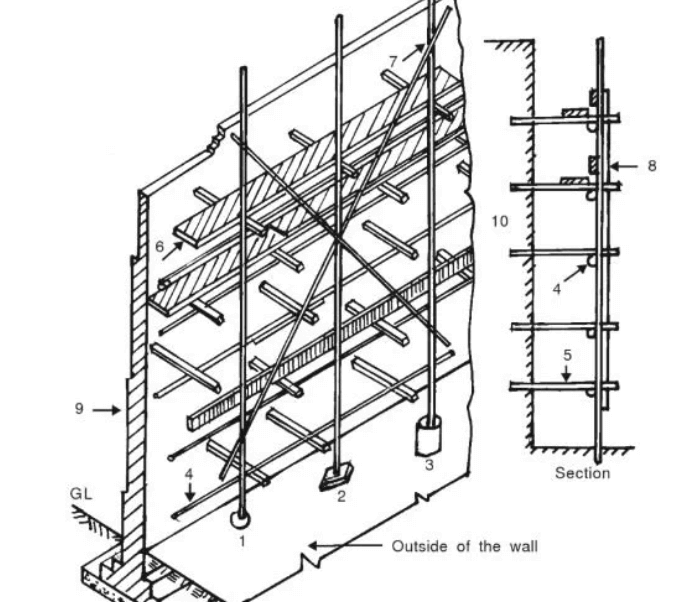
- Standards: These are the vertical posts which are also called as uprights.
- Ledgers: Ledgers are the horizontal members that are parallel to the wall.
- Braces: These are the bracing system.
- Putlogs: Putlogs are the horizontal members which are ordinary to the wall.
- Transoms: These are the putlogs whose the two ends are supported on ledgers in twofold scaffolding.
- Bridle: Bridles are the members used to bridge openings.
- Boarding: The boarding is a platform or planks on which the workmen used to stand.
- Guard rail: The rails that are given at around 1.0m level to guard the men those are working on the boarding.
- Toe board: Boards that are placed parallel to the boarding and close to the wall to offer protection to the workers.
- Sole plate or Base Plate: These are the plates which are on the ground that support standards.
So, here it is discussed about what is scaffolding, types of scaffolding in construction and parts of scaffolding in construction.
Construction Procedure of WBM Road
For more information click here.

Thanks for the article. Today i came to know that there are so many types of scaffoldings.